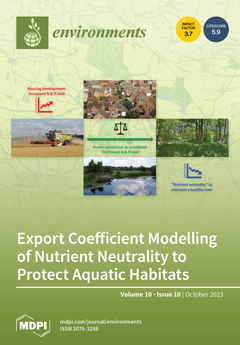The strain of red microalgae
Galdieria sulphuraria CCMEE 5587.1 was evaluated in a controlled laboratory environment for its ability to tolerate and remove two heavy metal (HM) ions: cadmium [Cd(II)] and lead [Pb(II)] in aqueous solutions as a single metal species. Various concentrations
[...] Read more.
The strain of red microalgae
Galdieria sulphuraria CCMEE 5587.1 was evaluated in a controlled laboratory environment for its ability to tolerate and remove two heavy metal (HM) ions: cadmium [Cd(II)] and lead [Pb(II)] in aqueous solutions as a single metal species. Various concentrations (0 mg L
−1 to 5 mg L
−1) of Cd and Pb ions were added to the Cyanidium medium in which the chosen microalgae strain
G. sulphuraria CCMEE 5587.1 was grown at an acidic pH of 2.5. The effectiveness of
G.
sulphuraria CCMEE 5587.1 in tolerating and removing these two metal ions was measured by analyzing its growth profile, growth rate, nutrient removal, and metal ion removal efficiency. The growth of
G. sulphuraria CCMEE 5587.1 was inhibited during the initial days of incubation, and the growth rate decreased when the HM concentration in the media was increased. Nutrient removal in the HM-containing media is comparable to that in the control media at low metal concentrations but decreases as the metal concentration rises.
G. sulphuraria CCMEE 5587.1 has the highest removal efficiency for Cd and Pb in a medium containing 2.5 mg L
−1 of metal ions, which is 49.80% and 25.10%, and the corresponding sorption capacity is 1.45 mg g
−1 and 0.53 mg g
−1 of dry biomass, respectively. These findings suggest that
G. sulphuraria CCMEE 5587.1 holds potential as a viable bioremediation solution for extracting Cd and Pb from wastewater, alongside its capacity to remove nutrients concurrently. The study underscores the dual advantage of
G. sulphuraria CCMEE 5587.1, making it a promising candidate for addressing heavy metal pollution in wastewater treatment processes.
Full article





